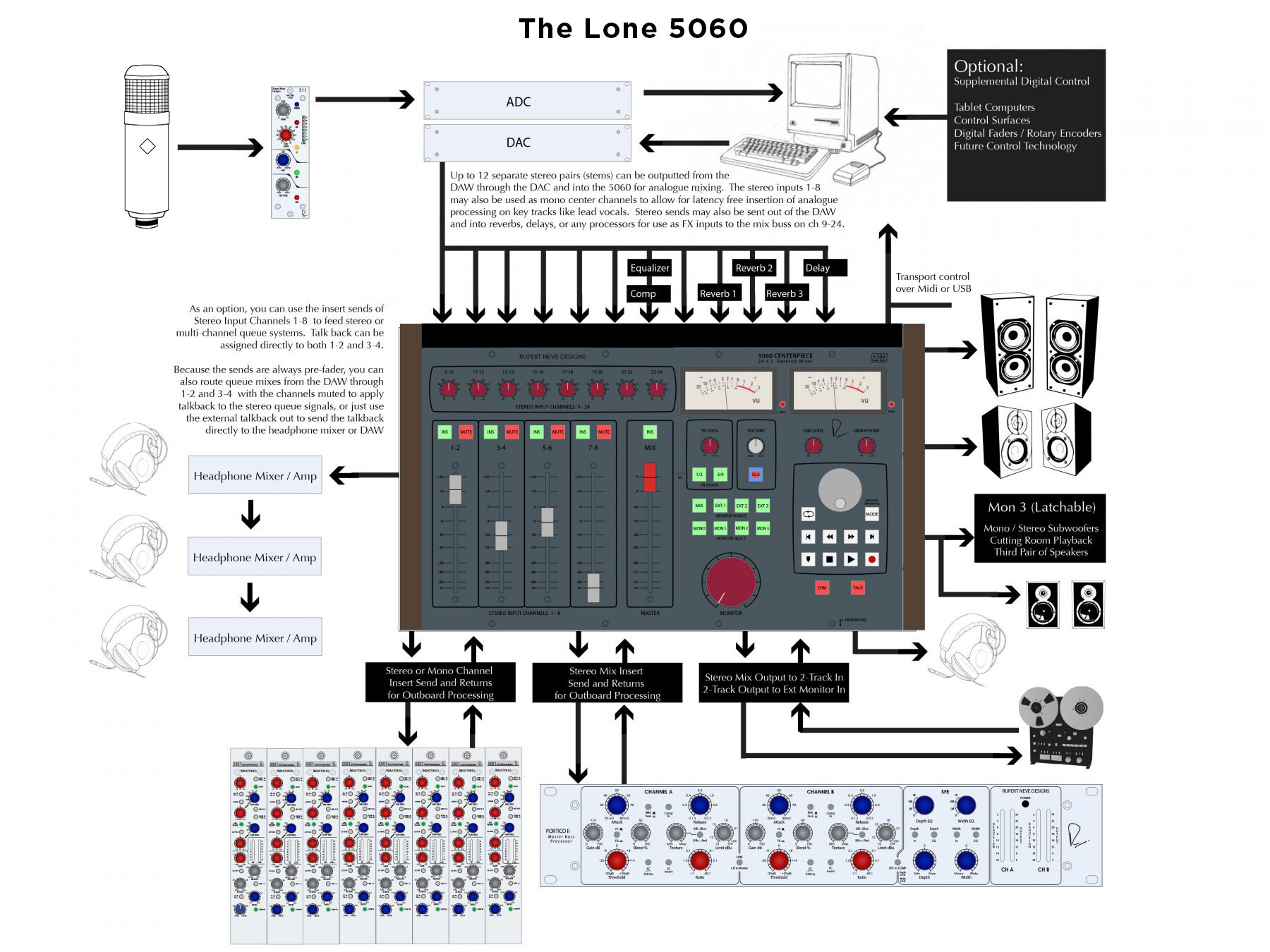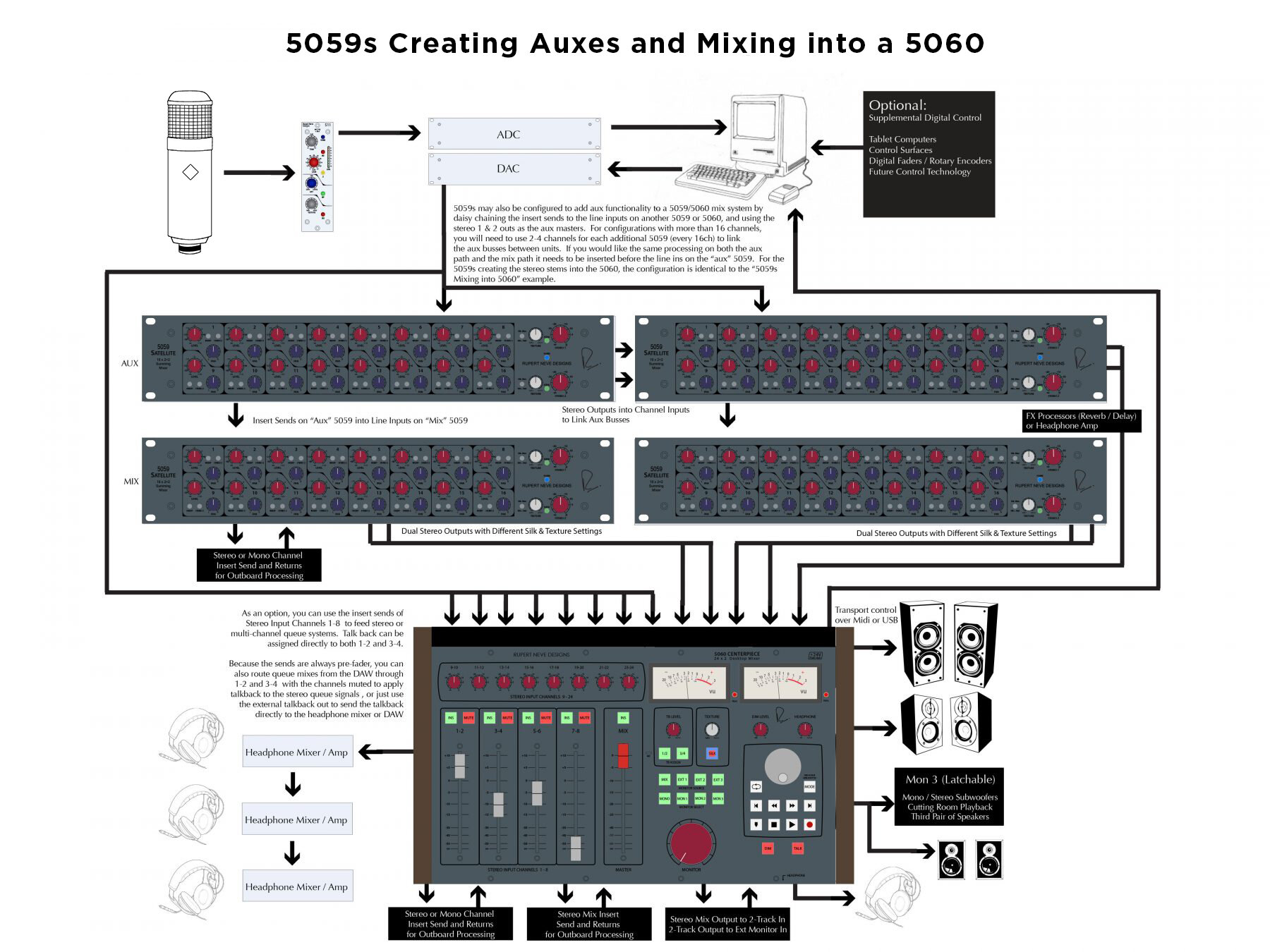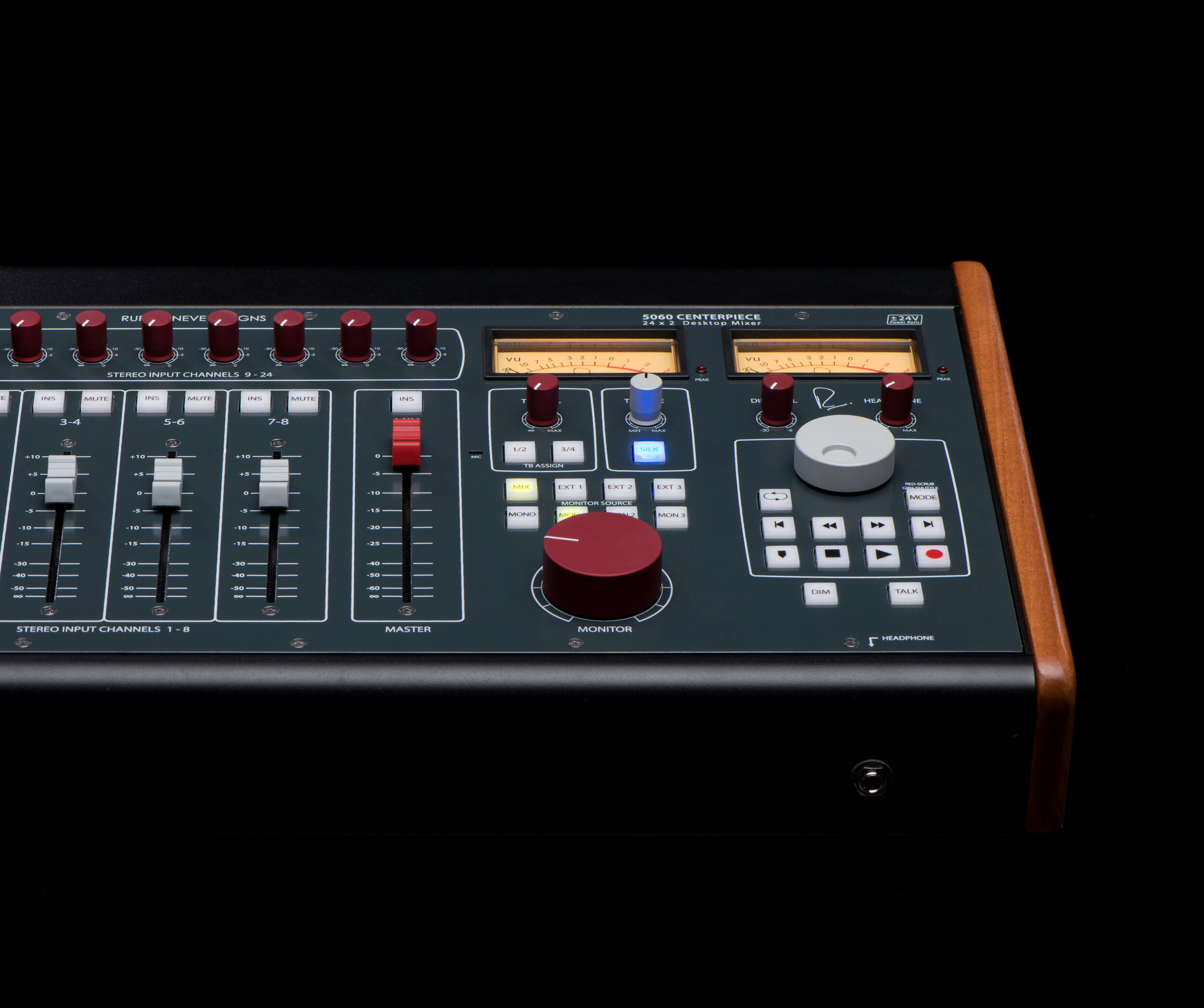
5060 CENTERPIECE
24 x 2 Desktop Mixer
OVERVIEW / MEDIA / FEATURES / REVIEWS / SPECS & RESOURCESThe class-A analog heart of your 21st-century studio.
Sized for your desktop, the 5060 puts the tonality and center section features of Rupert’s flagship 5088 console at your fingertips, cementing outboard together with serious custom transformers, flexible monitoring, DAW transport controls, and the raw power of a Rupert Neve-designed 24×2 mix-bus.
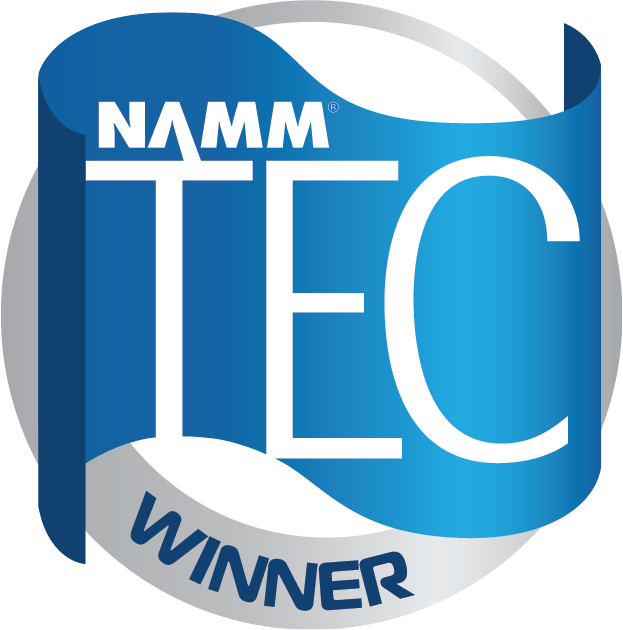
“The glue that holds my mixes together.”
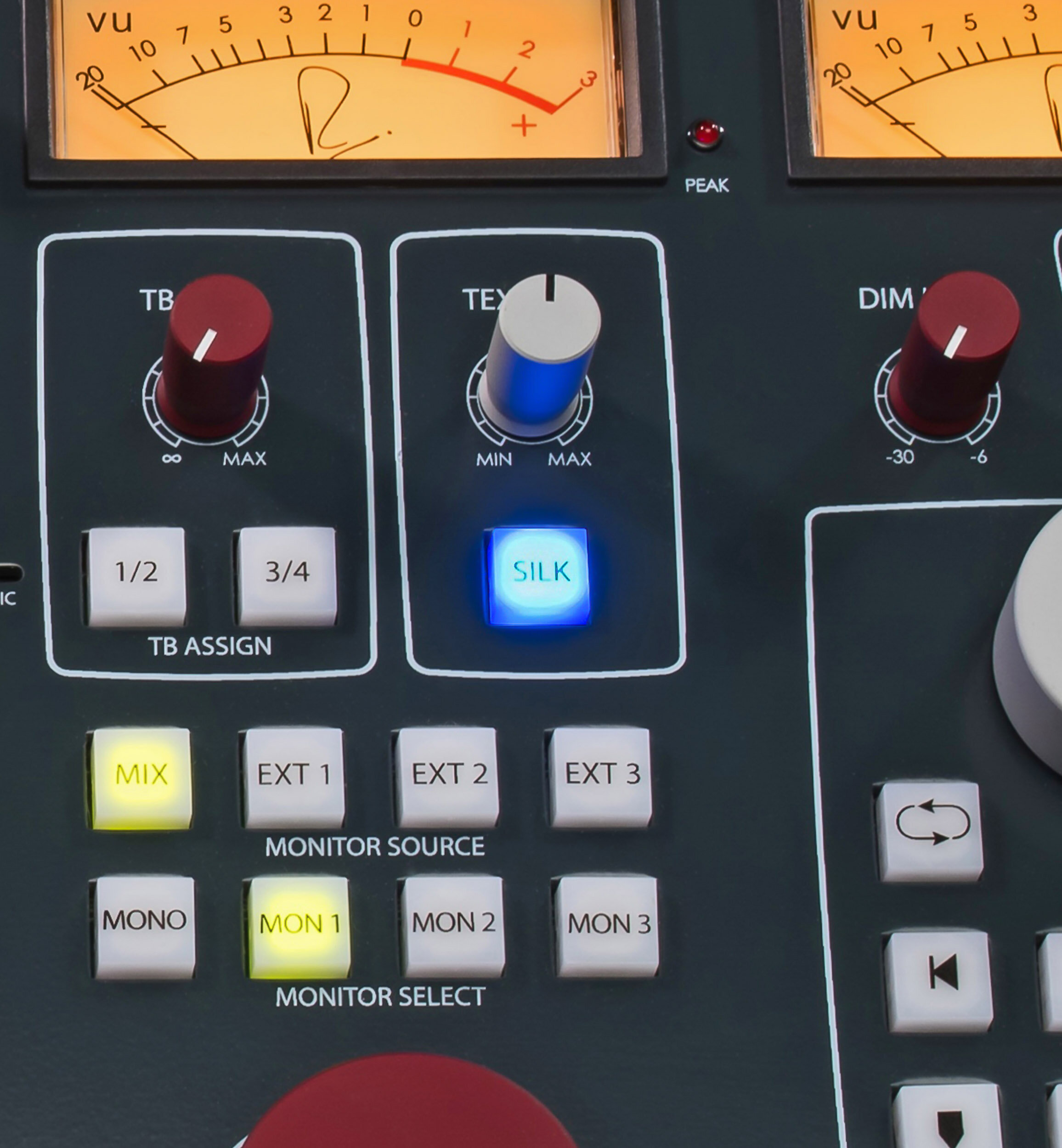
Define Your Tone.
With custom transformers, a class-A mix bus and variable Silk Red & Blue, the 5060 can provide a wide range of tonal flavors. Drive the mix bus hard and crank the Texture knob for a rich, saturated, vintage vibe – or disengage Silk entirely for clear, wide-open sonic beauty.
The Silk circuit reduces the negative feedback on the output transformer, adding harmonic content as the Texture is increased. Silk Red mode adds a sparkle & sheen to your mixes by accentuating the saturation in the high mids and highs, while Silk Blue amplifies saturation in the lows and low mids to add unparalelled weight & punch.
With Silk engaged, the 5060’s distortion characteristics and harmonic content are very reminiscent of many of Rupert’s class-A vintage designs – but here, these characteristics are fully variable. These controls add an unparalleled range of tonal options to the 5060, and open up a whole new world of sonic exploration.
Define Your Workflow.
With a modular, hybrid analog/digital mix system built around the 5060, you can outfit your studio with exactly what you need – and nothing that you don’t.
Utilizing modern DAW control technologies, the 5060 seamlessly integrates stem outputs from the DAW with the rest of your control room, sums the final mix, and provides 2-track outputs, source selection, and up to three speaker feed outputs from the monitor section.
Used in conjunction with Rupert Neve Designs’ other summing products and outboard equipment, the 5060 Centerpiece forms the core of a scalable analog system. In this arrangement, additional summing mixers provide expandable channel counts and aux routing capabilities, Shelford modules provide preamplification, EQ, and dynamics, and the Centerpiece unites it all. The 5060 brings your dreams of a seamless hybrid workflow to reality.
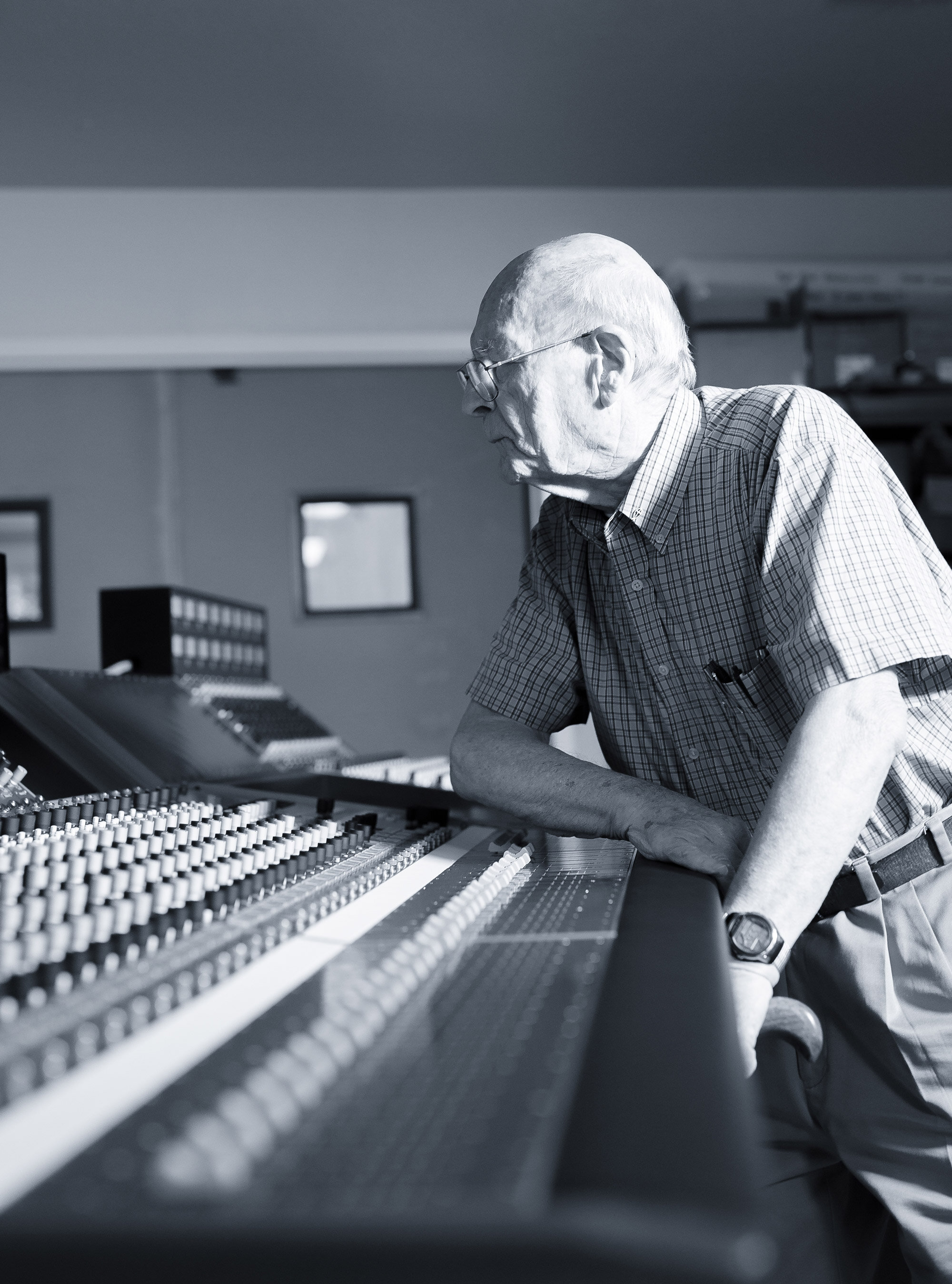
The New Analog Standard.
While digital technologies come and go, the modular, class-A analog designs Rupert created decades ago have been proven to stand the test of time. Instead of merely cloning these “classics”, Rupert’s team of engineers have crafted new designs – built on the same key principles – that take sonic performance, flexibility, and ergonomics to new heights.
These designs embody the high voltage, class-A, discrete and transformer-coupled architectures found in the 5088 console, which represent a culmination of Rupert’s vast analog circuitry knowledge. With the 5060 Centerpiece, the primary aim is to deliver the extraordinary quality of the 5088 in a compact, modular framework.
With exceptional fidelity, an abundance of interconnectivity and the tonal versatility of Silk, the 5060 is the ideal core of the sound-conscious modern studio.
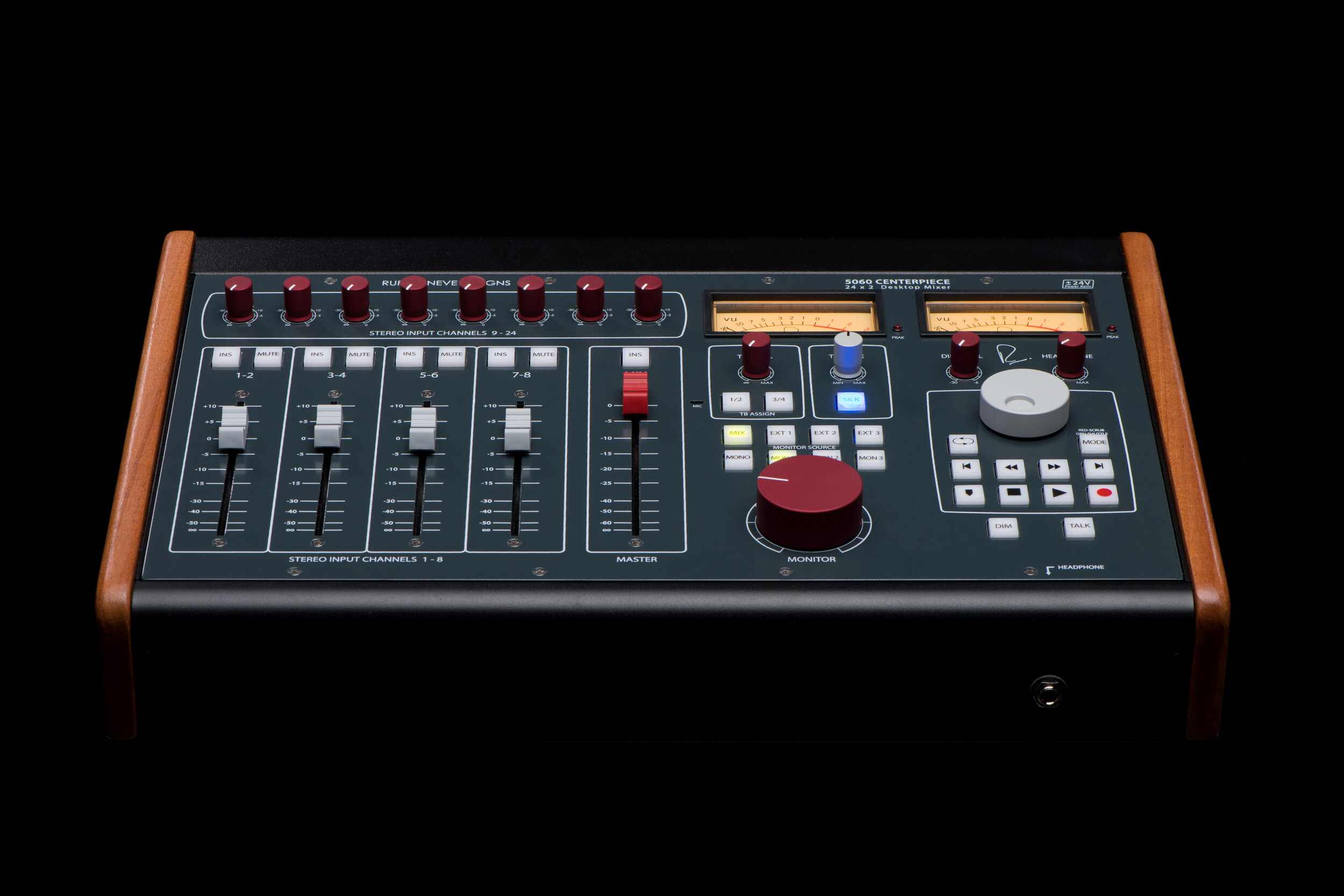
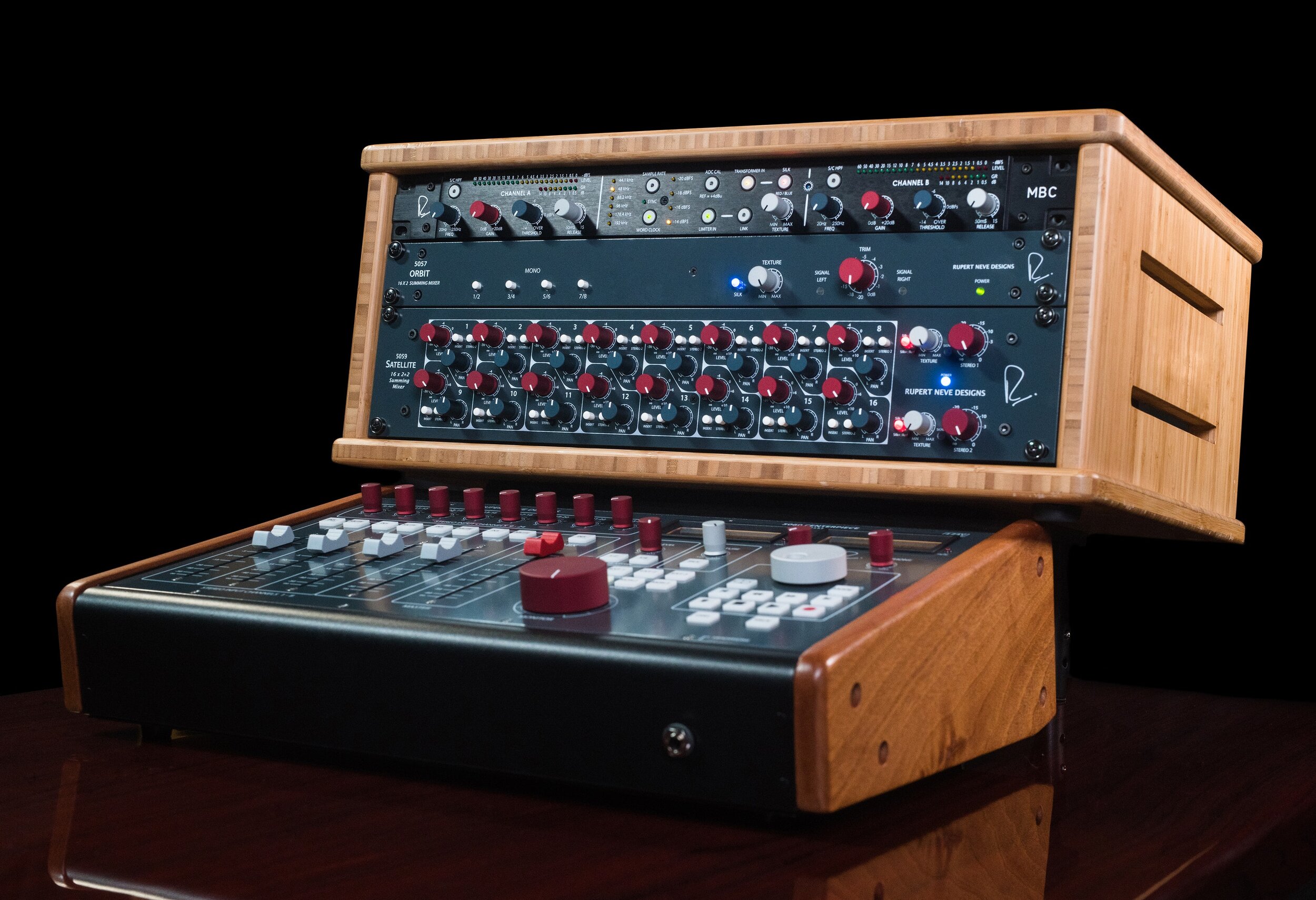

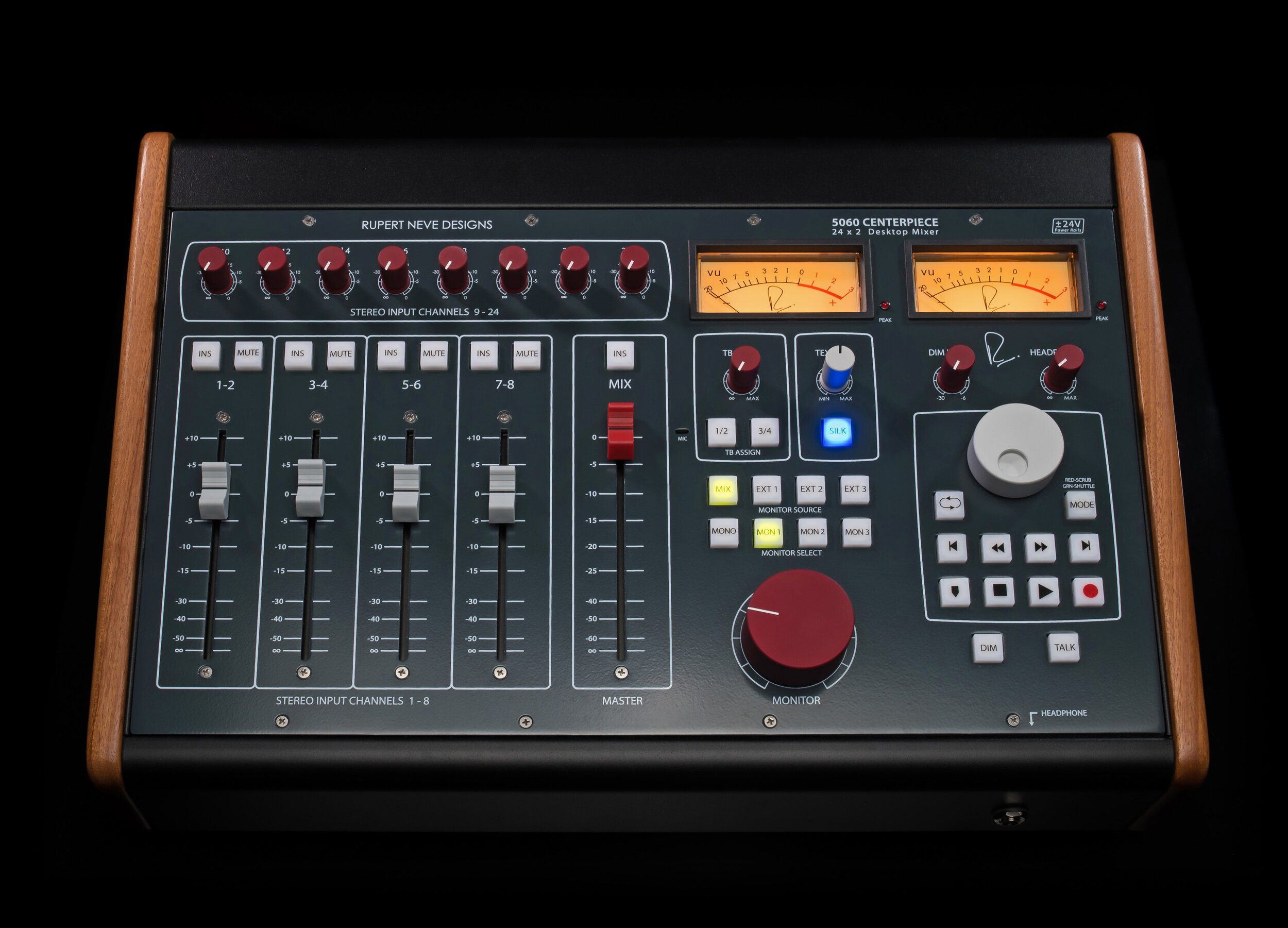
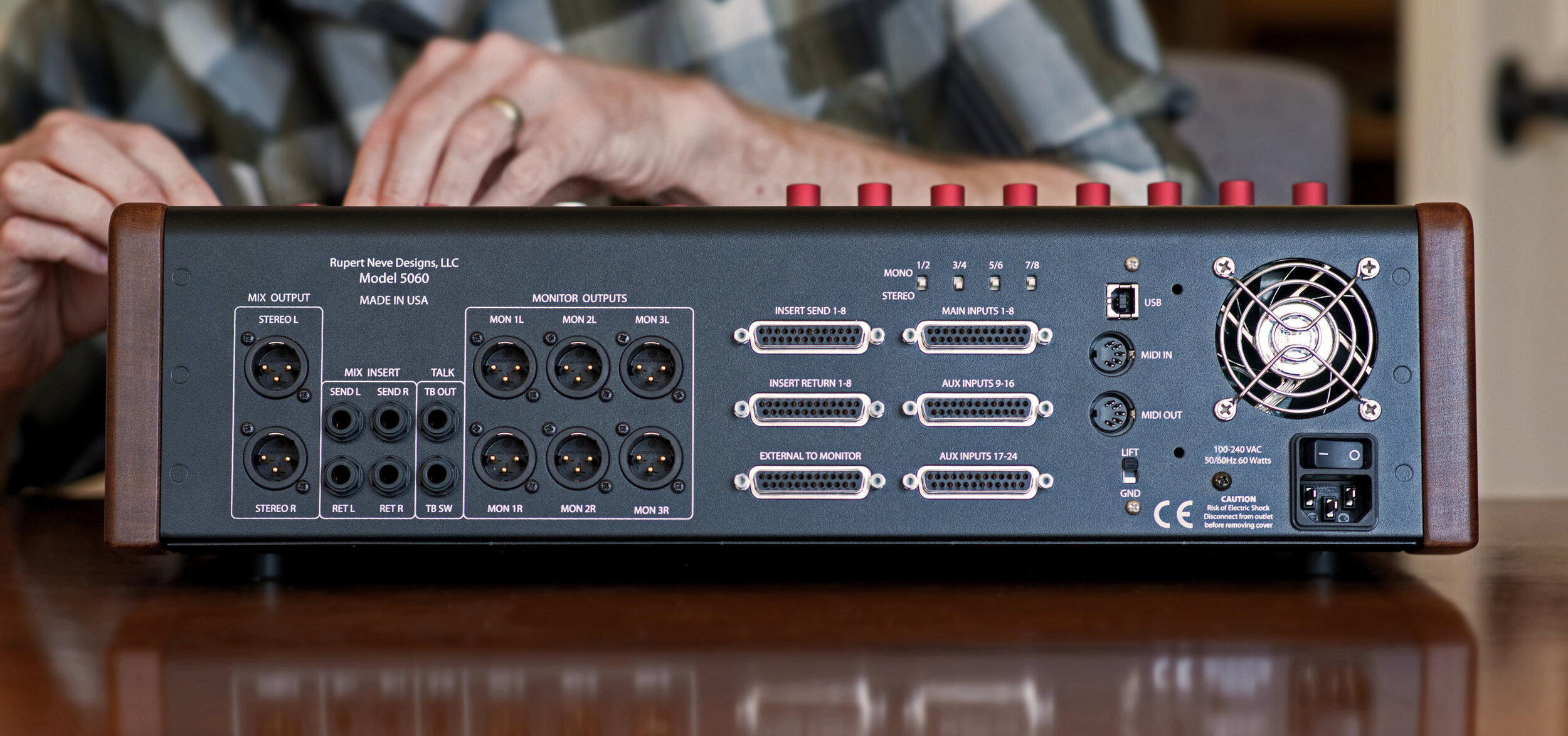
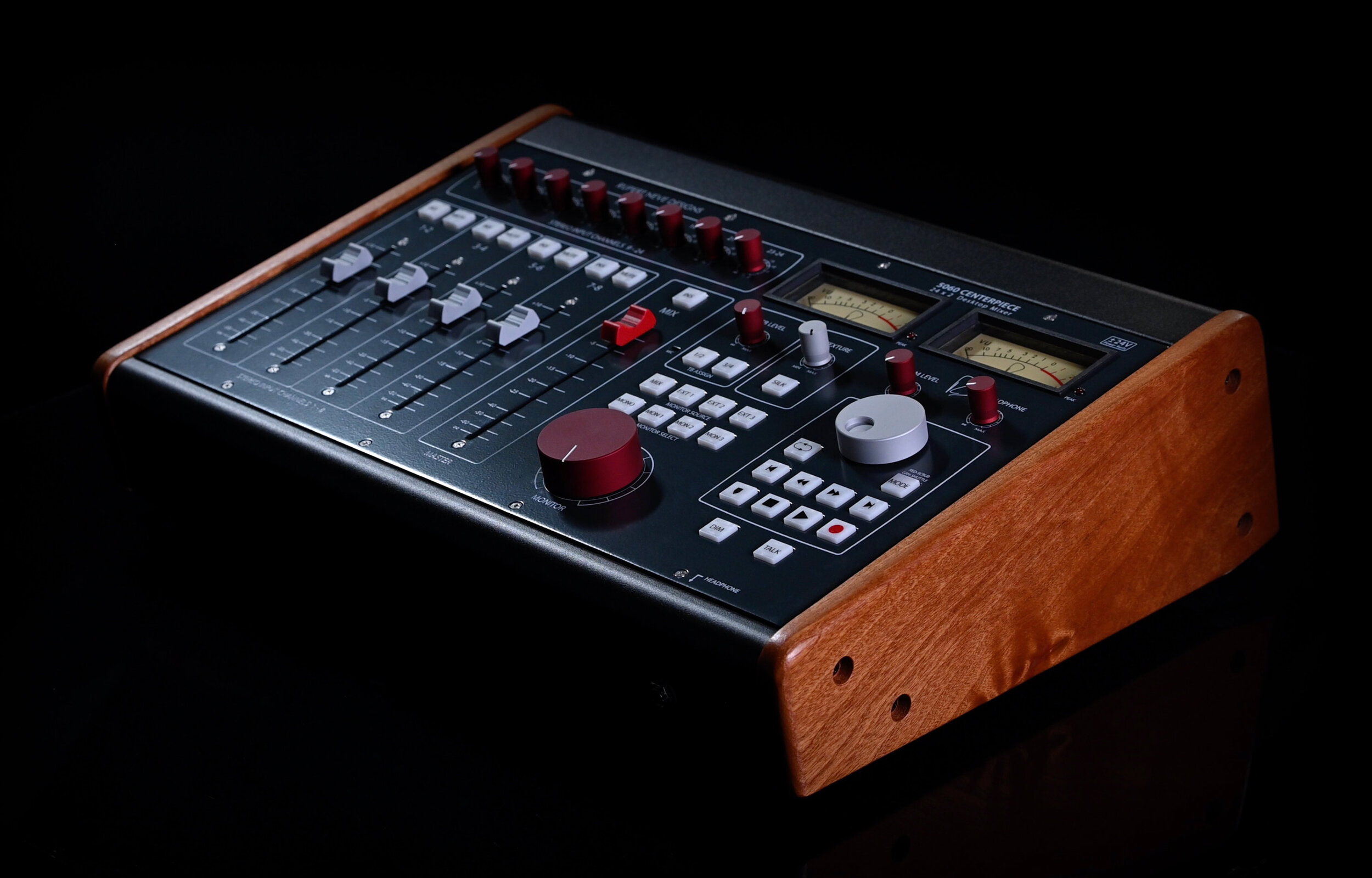
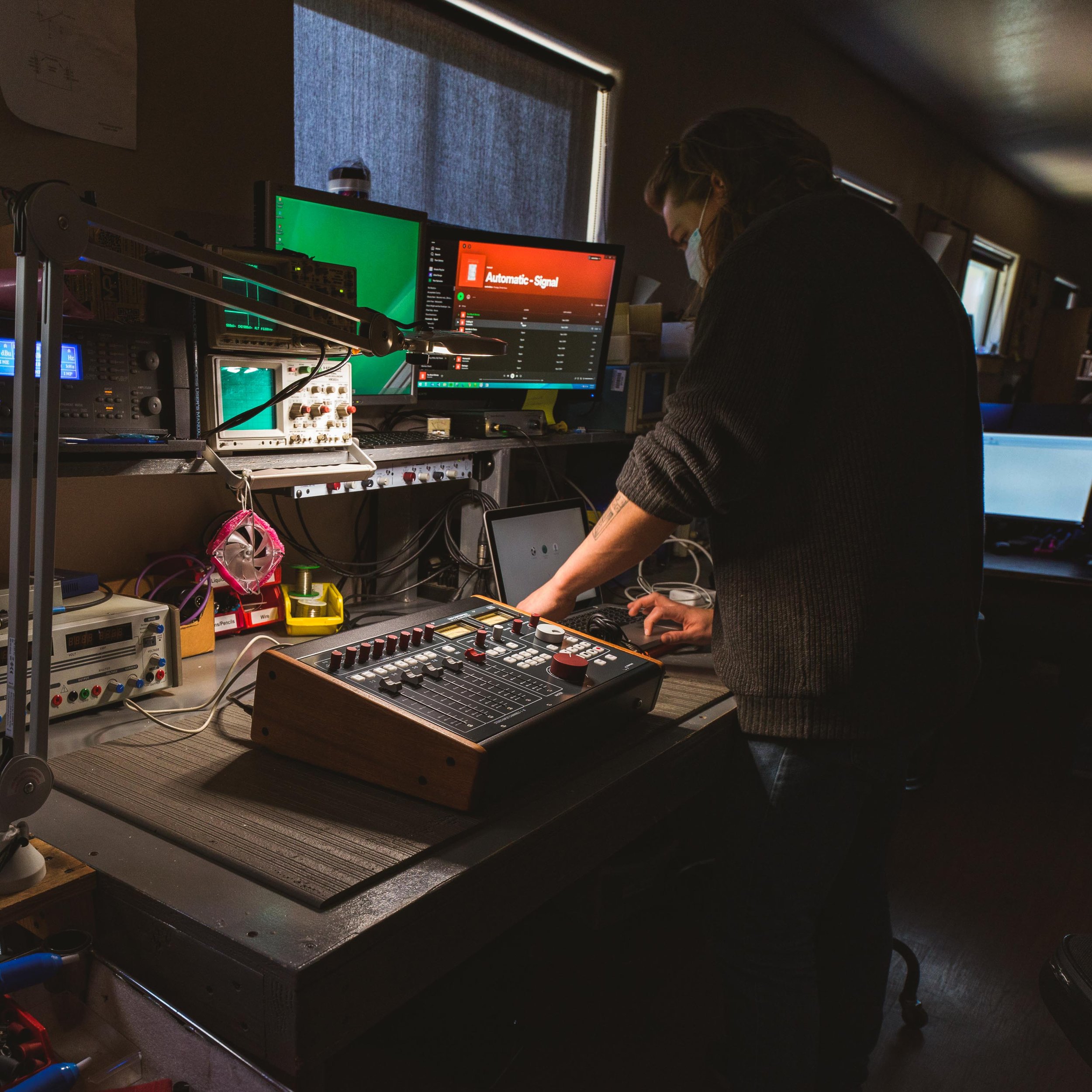

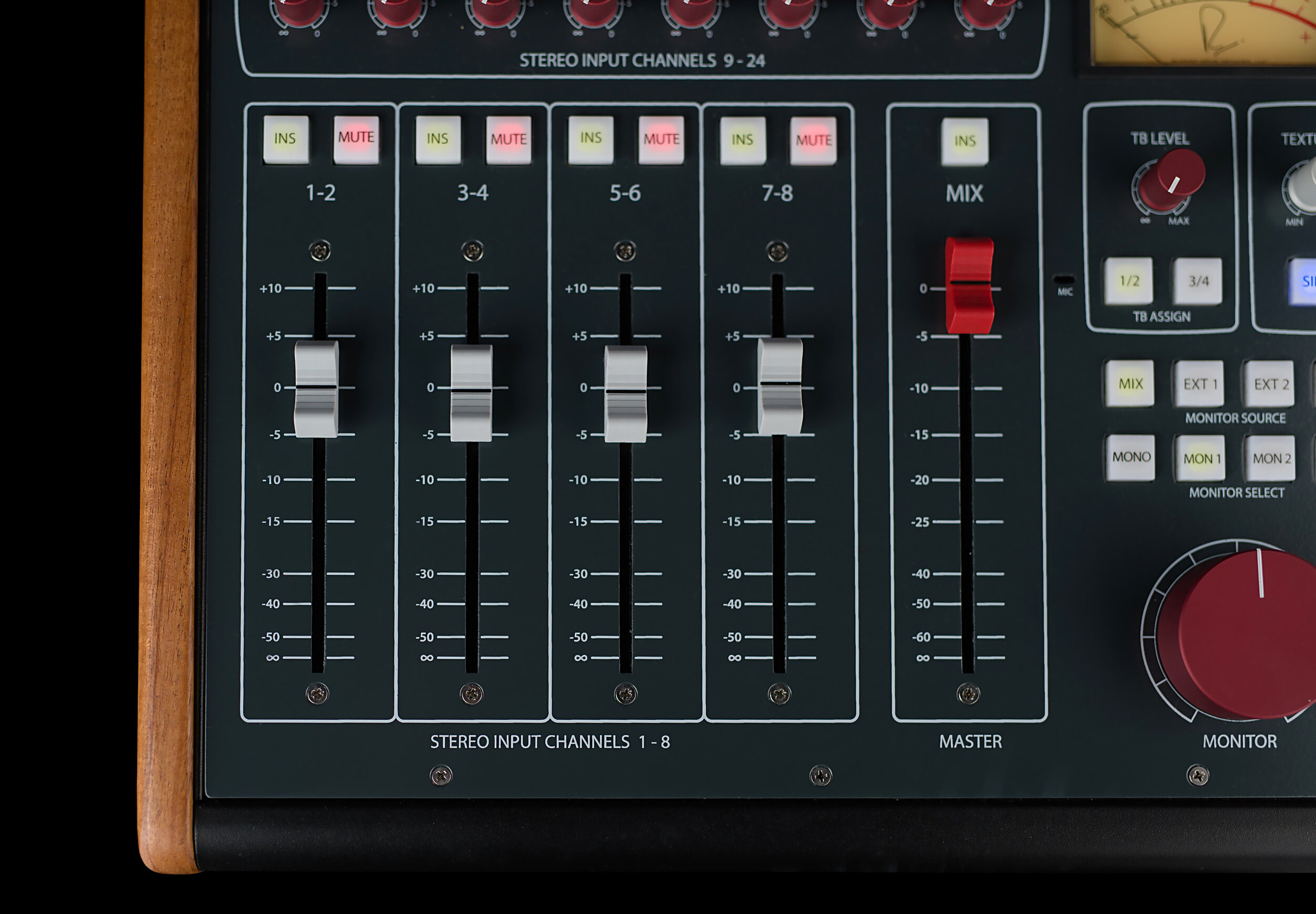
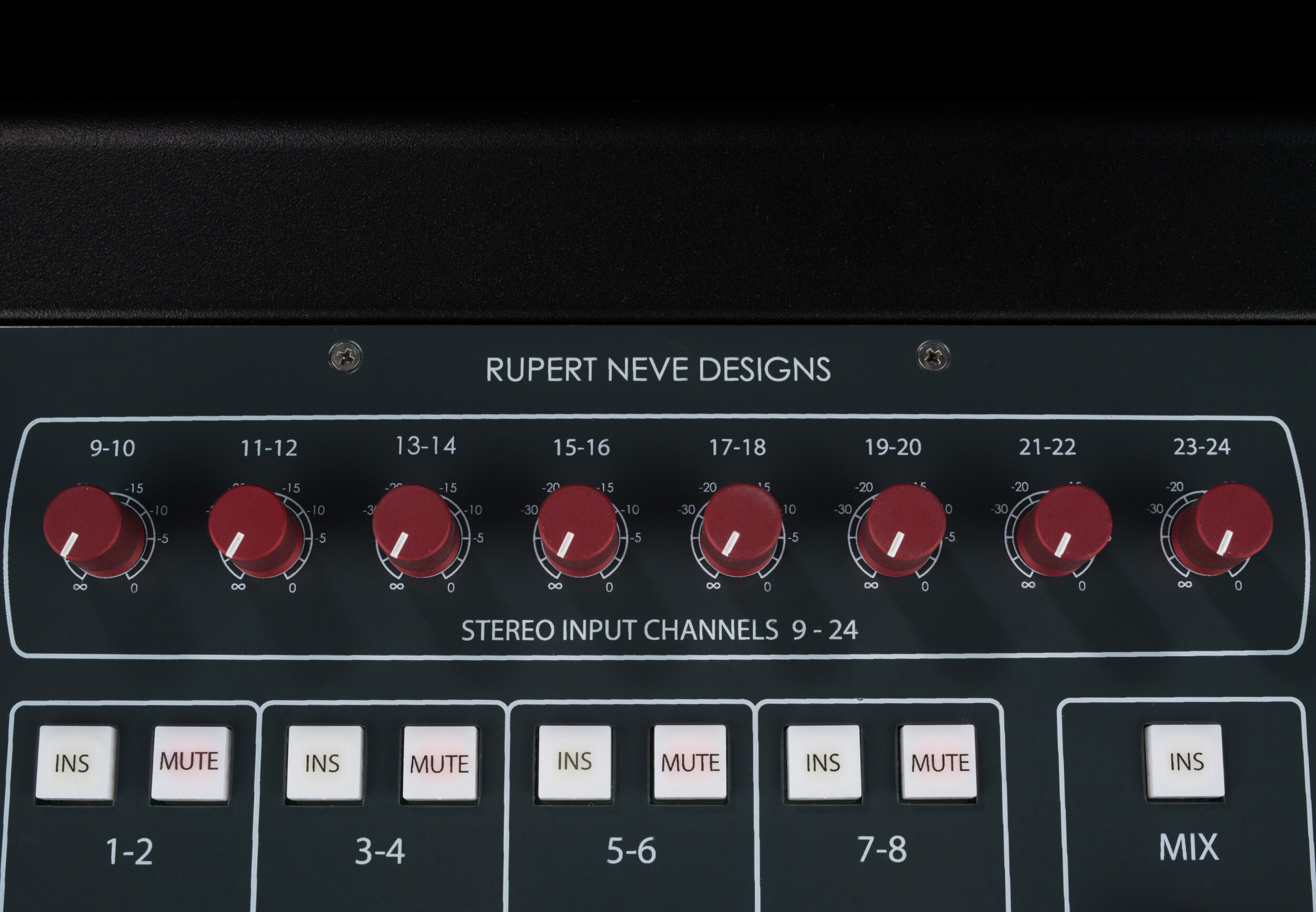
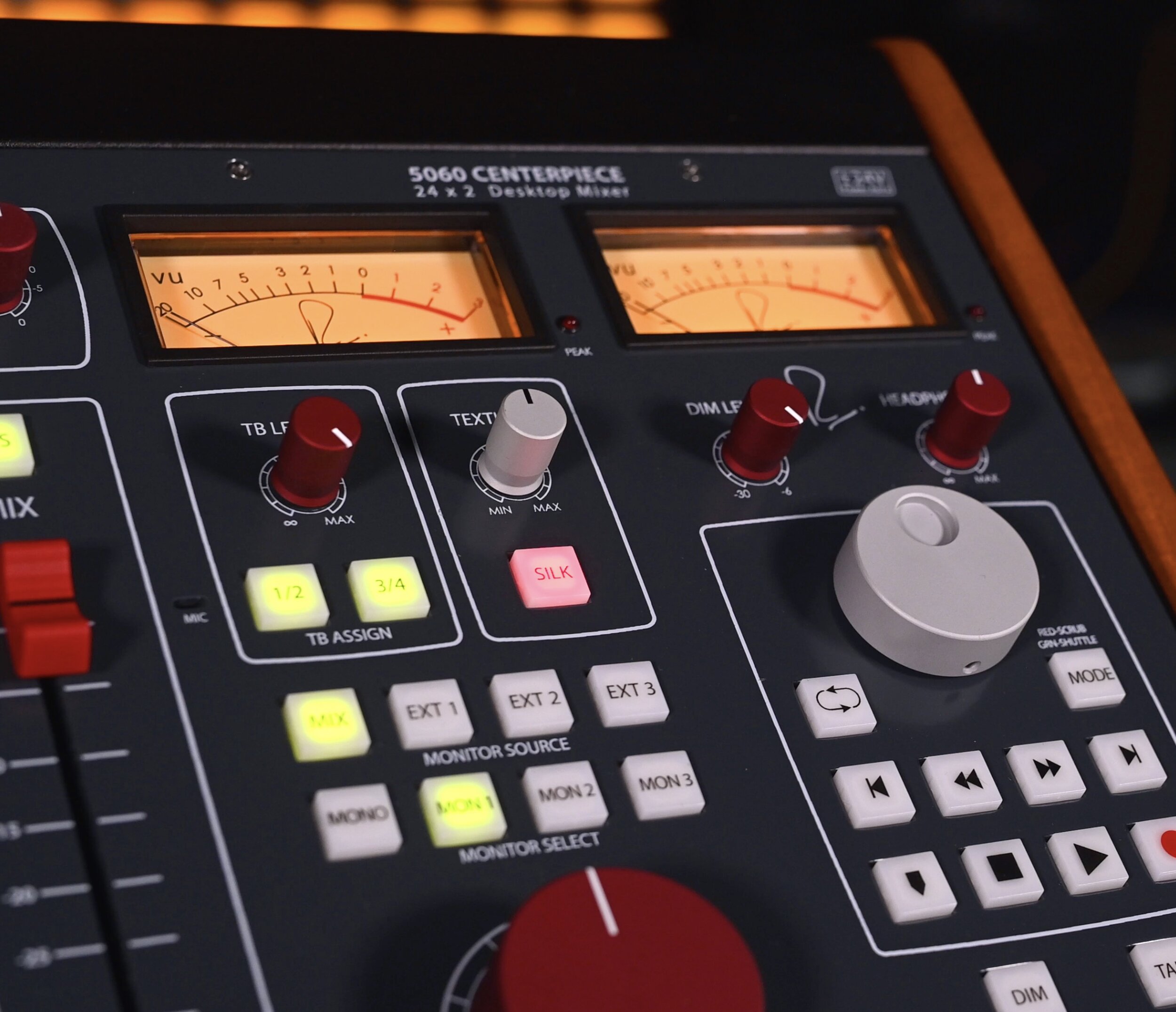
Stereo Input Channels 1-8
A professional grade 100mm fader determines the level of stereo input channels 1-8, with up to +10dB of additional line gain. Channels 1-8 can be either stereo or center-panned mono (via switches on the rear panel), and have both mute switches and inserts. The insert send of channels 1-2, and 3-4 has optional talkback assignment for use when feeding channels 1-8 through the 5060 to multichannel cue systems. The insert sends on channels 1-8 may also be used as a pre-fader send to a multi-track recorder.
Stereo Inputs Channels 9-24
Eight active stereo inputs with rotary faders for stem and aux inputs.
Stereo Bus Master
A 100mm stereo fader provides level control for the master stereo bus, outputting to both the stereo bus monitor signal and the stereo master output. For adding compression and EQ to the mix bus, there is also a transformer-coupled insert engaged by the Insert switch.
Texture & Silk Red / Blue
Continuously variable Texture controls with Silk Red and Silk Blue modes allow the engineer to fine-tune the harmonic ratio and tonality of the 5060’s outputs – or to leave each mix pristine and uncolored. The Silk Red mode accentuates the transformer saturation in the highs and high-mid frequencies to add a “sparkle” to the mix, while Silk Blue accentuates the saturation of the lows and low-mid frequencies to add thickness and density – especially useful for dry, somewhat anemic mixes.
Talkback
The included talkback mic is activated by depressing the Talkback switch. The Talkback has level control, a direct out, and assignment to insert sends 1-2 & 3-4. When the talkback switch is depressed, the speaker output levels are lowered according to the setting of the Dim control. A talkback remote may also be plugged into the ¼” talkback remote input on the back of the 5060.
Transport Controls
Standard transport functions in DAWs including play, stop, record, fast-forward, rewind, loop, shuttle / jog and marker drop are controlled through MIDI or USB interconnection.
Monitor Source
Selects the monitor source from between the stereo bus and three external monitor inputs.
Monitor Select
Selects which speaker output is active. By holding the Mon 3 button, the Mon 3 outs will “latch” on, allowing both Mon 1 & 2 to be used with subwoofers or speakers in the cutting room.
Headphone Amplifier
A class-A reference-grade headphone amplifier with headphone level control. The headphone signal follows the selection of the monitor select.
Monitor Level
A precision 21-step attenuator provides highly accurate left/right stereo tracking, perfect repeatability, and determines the level of the monitor output.
Meters
VU meters display the RMS signal level of the selected monitor source, and the peak indicator illuminates red when the peak threshold has been exceeded.
Dim
Engaged when either the Dim or Talkback switch is depressed, Dim reduces the monitor volume between -6dB and -30dB.
REVIEWS
"The difference in mixing in the box versus through that summing mixer...the sound fascinated me. I set the console up where I'm generating a straight digital mix and an analog summed mix, and I can switch back and forth – and I've shown many people this, it's astounding. It's unbelievable the effect that it has...it's made me care so much."
Toby Francis, FOH Engineer
Red Hot Chili Peppers, Ariana Grande, Katy Perry
“The 5060 is an amazing piece of gear to behold…It’s kind of like sitting down into a new Mercedes, it feels like it’s built like a bank vault and every piece has been considered and carefully selected. This is not something you’ll feel like replacing anytime soon.”
“I’ve done a ton of mixing on the Stratosphere Studios (R.I.P.) Neve 8068, and pushing that mix bus hard was always the key to getting a great mix, especially if the material had a healthy amount of distortion. The 5060 worked exactly the same way, with the Silk “Red” engaged, and the Texture set to about halfway, the more I hit the mix bus, the better it sounded. I could basically beat the mix I had going within an hour of playing with this new mixer, which is definitely amazing on a heavy complex mix like this. If I had started with this mixer from the beginning, I probably could have even pushed it further into sonic nirvana (nerdvana?).”
“This thing is noiseless and perfect, and sound-wise it's an absolute delight to get everything through it and engage some amount of silk red on the whole mix. It is a summing mixer, and for us its real purpose is defining our workflow. Everything revolves around it, and it’s a safe feeling. Reliable…It's scary to think about something this well engineered and planned. I did this review as a happy customer, so there you go.”
“I knew what the big console sound was and how it affected tracking and eventually mixing. I was able to get close doing it all in the box but never had that sonic footprint that I used to get back in the day multi-tracking with a big console and laying it all down to 2-inch tape. That is until now…The 5060 is one of the best investments I have ever made in my studios. I couldn’t be happier unless of course I had a complete 24 channel 5088, and who knows, that may happen some day. But for now at least, I have that sound and that is everything in my opinion.”
Customer Reviews via gearspace.com
“I bought the 5060 about a month ago and it has truly been a game changer for me. 24 channels of summing, the master section from the 5088, same monitoring as the 5088, monitor select, awesome headphone amp, what more could you ask for? It sounds incredible. When I received it I ran some previously completed mixes through it so that I could A-B them and hear the difference. The difference was not subtle. The silk feature along with the ability to push the master section really makes a huge difference. I also love the ability to have analog inserts on channels 1-8 and on the Master. This is awesome and speeds up workflow. I am very happy that I pulled the trigger and bought this. Rupert Neve is a genius and the Centerpiece not only looks sexy, it sounds huge!”
Customer Review via vintageking.com
“It feels just like the old school mixers that I cut my teeth on. I love it! Very similar to working on 5088. Coupled with my outboard tube gear, it instantly elevates all mixes!”
“Just a must-have. This product makes all you DAW lovers appreciate headroom that plugins and just Pro Tools alone can’t give you. Also it’s very intuitive and flexile…I will never mix a project again without it.”
“The Centerpiece is a Masterpiece! This mixer has something about it that just makes it fun to use – great layout, looks amazing, and most importantly, sounds amazing. You definitely get what you pay for with this unit. The controls are very smooth, driving the mix bus does just what they say it does…”
“My best investment…If you are seriously thinking about sound quality in your studio, save your pennies, and get this unit, you will never feel bad about this investment, your clients and your ears will be grateful, work with this unit every day will be fun...”
Customer Reviews via sweetwater.com

SPECIFICATIONS & DOWNLOADS
MAX INPUT LEVEL
Channels 1 - 8, fader at 0dB: greater than +26 dBu
Channels 9 - 24, level trim at 0dB: greater than +22 dBu
STEREO OUTPUTS
Unless otherwise specified, frequency is 1 kHz.
MAX OUTPUT LEVEL
Any combination of inputs: greater than +27 dBu
THD+N
Channels 1 - 8, fader at unity, BW <10 Hz – 80 kHz
+20 dBu, 20 Hz: 0.03%
+20 dBu, 2 kHz: 0.003%
+20 dBu, 20 kHz: 0.02%
Channels 9 - 24, trim at unity, BW <10 Hz - 80 kHz
+20 dBu, 20 Hz: 0.03%
+20 dBu, 2 kHz: 0.004%
+20 dBu, 20 kHz: 0.02%
NOISE (BW 22 Hz - 22 kHz)
Channels 1 - 24 at unity: Better than -90 dBV
Channels 9 - 24 at unity, 1-8 muted: Better than -100 dBV
X-TALK
Channel to Channel: better than 60 dB
CMRR
1 kHz input to channel 1, 0 dBu fader at unity: -70 dBu
FREQUENCY RESPONSE
10 Hz to 120 kHz: +/- 0.25 dB
IMD
+4 dBu, CCIF/DFD: Better than 0.0008%
SILK BLUE / SILK RED (Texture control at maximum)
DISTORTION
+20 dBu in, 20 Hz: Up to 5%
+20 dBu in, 200 Hz: Up to 0.2%
MONITOR OUTPUTS
MAX OUTPUT LEVEL
1 kHz: +25 dBu
THD+N
+20 dBu, 20 Hz: Better than 0.03%
+20 dBu, 2 kHz: Better than 0.02%
+20 dBu, 20 kHz: Better than 0.02%
MINIMUM LOAD
Monitor and Line Outputs: 3K Ohms
HEADPHONE OUT
MAX OUTPUT LEVEL
Greater than +20 dBu, unloaded
THD+N
2 kHz into 68 Ohms, 16 dBu output: Better than 0.02%
NOISE
From 22 Hz – 22 kHz: Better than -85 dBV
MINIMUM LOAD (headphone out)
16 Ohms recommended
PEAK LEDs
Engage Threshold: +22 dBu
POWER CONSUMPTION
AC Mains, 100VAC to 240VAC, 50/60Hz: 110 Watts Max
Fuses: not user accessible, internal on power supplies
OPERATING TEMPERATURE RANGE: 0 to 35 degrees C
STORAGE TEMPERATURE RANGE: -10 to 50 degrees C
OPERATING HUMIDITY RANGE: 10% to 95% Non-Condensing
UNIT DIMENSIONS
18.5” W x 12.5” D x 5.75” H
(47 cm W x 31.8 cm D x 14.6 cm H)
UNIT WEIGHT
22 lbs. (10 kg)
SHIPPING DIMENSIONS
24” W x 18” D x 12” H
(61 cm W x 45.7 cm D x 30.5 cm H)
SHIPPING WEIGHT
29 lbs. (13.2 kg)
FREQUENTLY ASKED QUESTIONS
The summing architecture is essentially the same between all three of our Summing Family mixers. They each have different feature sets to address different needs, but sonically they’re all nearly identical. The main exception would be the secondary -6dB output on the 5057, which reduces the likelihood of clipping the next device in the chain when driving the unit very hard, and thus may allow for greater potential harmonic saturation.
A subwoofer can be connected to the MON 3 outputs, which can be latched by holding the MON 3 switch for 3 seconds. Alternatively, for stereo subwoofers you could also use “Y” cord outputs from the monitors that you wish to pair with the subwoofer.
Yes, this is normal. Mono switches on the 5060 center-pan the first track of the pair (e.g. 1, 3, 5, or 7), and mute the second track of the pair (2, 4, 6, or 8).
Note: this is different from how the mono switches operate on the 5057 Orbit, which instead center-pans and sums the track pairs together (1+2, 3+4, etc).
Generally people record the mix output into a stereo input in their DAW, but you can also record to an external tape machine or other “2-track” destination.
Not necessarily. We’ve been conditioned to see red peak lights as meaning “bad” – but remember, this is analog, not digital. Oftentimes, the “glued-together” sound we’re looking for from an analog mix buss comes from overdriving the output stage, and this may mean some peaks here and there. Just like with a real analog mixing console, use your ears to tell you when you’re hitting the mix too hard.




